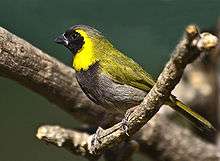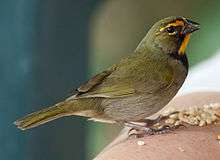Tiaris
| Tiaris | |
|---|---|
 | |
| Black-faced grassquit (Tiaris bicolor) | |
| Scientific classification | |
| Kingdom: | Animalia |
| Phylum: | Chordata |
| Class: | Aves |
| Order: | Passeriformes |
| Family: | Thraupidae |
| Genus: | Tiaris Swainson, 1827 |
| Species | |
|
5, but see text | |
Tiaris is a genus of songbirds in the tanager family (Thraupidae), containing the bulk of the grassquits.
The genus was introduced by the English naturalist William John Swainson in 1827. The type species is the yellow-faced grassquit.[1][2] The name is from the Ancient Greek word tiara for "head-dress".[3]
The genus contains the following species:[4]
| Image | Scientific name | Common Name | Distribution |
|---|---|---|---|
 | Tiaris canorus | Cuban grassquit | Bahamas, Cuba, and Turks and Caicos Islands |
.jpg) | Tiaris fuliginosus | Sooty grassquit | Argentina, Bolivia, Brazil, Colombia, Guyana, Paraguay, Trinidad and Tobago, and Venezuela |
_(cropped).jpg) | Tiaris obscurus | Dull-coloured grassquit | Argentina, Bolivia, Colombia, Ecuador, Peru and western Venezuela. |
 | Tiaris olivaceus | Yellow-faced grassquit | central Mexico to northern Ecuador and north-western Venezuela |
_male.jpg) | Tiaris bicolor | Black-faced grassquit | West Indies except Cuba, on Tobago but not Trinidad, and along the northern coasts of Colombia and Venezuela. |
However, these might not be monophyletic relatives, and warrant the splitting off of some species or merging this genus in another. Phylogenetic studies have hitherto failed to place this genus firmly with respect to a large number of species in the group called "Tholospiza", which typically build nests covered by a dome of material. This group consists of radiations out of Central America, into the Caribbean and into the Pacific. The latter group of these American sparrow-like tanagers are the famous Darwin's finches (including the Cocos finch, Pinaroloxias inornata). The former group includes the Caribbean bullfinches (Loxigilla), the Saint Lucia black finch (Melanospiza richardsoni), the yellow-shouldered grassquit (Loxipasser anoxanthus) – though not the blue-black grassquit (Volatinia jacarina) –, and probably other Caribbean genera too (e.g. orangequit, Euneornis campestris and the puzzling bananaquit, Coereba flaveola).[5]
References
- ↑ Swainson, William (1827). "A synopsis of the birds discovered in Mexico by W. Bullock F.L.S. and H.S., and William Bullock, jun". Philosophical Magazine. 2nd Series. 1: 433-442 [438].
- ↑ Swainson, William (1828). "On several groups and forms in ornithology, not hitherto defined". Zoological Journal. 3 (11): 343-363 [351].
- ↑ Jobling, J.A. (2018). del Hoyo, J.; Elliott, A.; Sargatal, J.; Christie, D.A.; de Juana, E., eds. "Key to Scientific Names in Ornithology". Handbook of the Birds of the World Alive. Lynx Edicions. Retrieved 2 April 2018.
- ↑ Gill, Frank; Donsker, David, eds. (2018). "Tanagers and allies". World Bird List Version 8.1. International Ornithologists' Union. Retrieved 2 April 2018.
- ↑ Burns et al. (2003), Jønsson & Fjeldså (2006), Klicka et al. (2007)
- Burns, K.J.; Hackett, S.J. & Klein, N.K. (2003): Phylogenetic relationships of Neotropical honeycreepers and the evolution of feeding morphology. J. Avian Biol. 34(4): 360-370. doi:10.1111/j.0908-8857.2003.03171.x PDF fulltext
- Jønsson, Knud A. & Fjeldså, Jon (2006): A phylogenetic supertree of oscine passerine birds (Aves: Passeri). Zool. Scripta 35(2): 149–186. doi:10.1111/j.1463-6409.2006.00221.x (HTML abstract)
- Klicka, J.; Burns, K. & Spellman, G.M. (2007). Defining a monophyletic Cardinalini: A molecular perspective. Mol. Phylogenet. Evol. 45(3): 1014-1032. doi:10.1016/j.ympev.2007.07.006 PDF fulltext